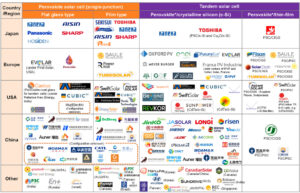Although single-crystalline silicon (sc-Si) solar cells currently dominate the global PV market, perovskite solar cells (PCSs) are drawing worldwide attention as a next-generation solar cell because of its high conversion efficiency, light weight, flexibility, and expected low cost.
At the 34th International Photovoltaic Science and Engineering Conference (PVSEC-34) held in Shenzhen, China, in November 2023, papers on “Perovskite and tandem solar cells and modules” accounted for 31% of a total of 589 papers submitted, exceeding the ratio of papers in the area of crystalline silicon (c-Si) solar cells and modules (19%). Especially highlighted was research in the area of PSCs in China, which is now vigorous and progressing.
A similar trend was observed at the European Photovoltaic Solar Energy Conference and Exhibition (EU PVSEC) 2023 held in September 2023, where a large number of reports were made on the area of PSCs. Of a total of 1,003 papers submitted, 24% was those in the area of “thin films and new concepts” including PSCs, whose number is comparable to those in the area of c-Si. In addition, papers on single-junction PSCs and papers on tandem PSCs were approximately the same in number, which indicated that the research and development (R&D of tandem solar cells) has been accelerating. In particular, European research institutions are focusing on the development of perovskite/silicon tandem solar cells utilizing the accumulated accomplishments of R&D on c-Si solar cells.
PSCs are expected to achieve higher conversion efficiency, lower material costs, and low-carbon footprint processes, etc., but on the other hand, double glass or high-performance films are required to ensure environmental resistance, and whether they can be compared favorably with c-Si solar cells in terms of manufacturing costs is an open question for the future. In addition, flexible c-Si PV modules have already been commercialized, and competition with c-Si solar cells in the flexible and lightweight solar cell market is inevitable. As for tandemization with c-Si, an issue of balancing the increase in process cost and the performance remain to be solved. Demonstration tests of solar cells for power generation projects that require a durability of 20 years or more have just begun. As mentioned above, the technology development of PSCs for commercialization will further gain momentum from now forward.
As shown in Figure 1, since 2020, venture companies and existing solar cell manufacturing and development companies are joining in the development of PSCs (single-junction and tandem type) one after another, and the race of technology development is intensifying. Companies working on single-junction solar cells aim to commercialize products toward expanding new applications, and some companies have already started operating small-scale or pilot production lines abroad. At PVSEC-34, several Chinese companies reported on practical-size perovskite PV modules with a double-glass structure, which passed the IEC standard test, as well as the results, etc. for power generation measurement in outdoor installation.
In Japan, next-generation solar cells are being developed as part of the Green Innovation Fund project, and the technology development of single-junction PSCs is underway in collaboration with the users. With the goals of simultaneously establishing mass production technology, creating demand, and developing a GW-class production framework, early social implementation of PSCs is aimed as a major national project. However, in order to survive the fierce international competition, the framework for technology development should be speedily strengthened and accelerated. Moreover, tandem solar cells using PSCs are expected to be highly efficient products with a conversion efficiency of more than 30%, and thus c-Si solar cell manufacturers in various countries are now working on their technology development. In Japan, it is considered necessary to further strengthen the PSC technology for development of tandem solar cells with c-Si, in addition to development of single-junction solar cells.
Diversification of installation locations is required for PV power generation, which is expected to play an important role in the future of decarbonization, and the value of the development of PSCs having an opportunity to create a new market is significant. On the other hand, the production capacity of c-Si solar cells is expected to exceed 1 TW/year by 2024, taking the lead in aspects of both technology and utilization, and they will continue to dominate the market until at least 2030. In the USA, Europe, and India, efforts are underway toward restructuring the c-Si solar cell manufacturing supply chain. In order to promote the expansion of PV introduction in Japan, it is vital to realize domestic production of solar cells, by making an all-out effort among industry, government, and academia to win the race of technology development and commercial production of next-generation solar cells, while securing measures for stable procurement of c-Si solar cells.

